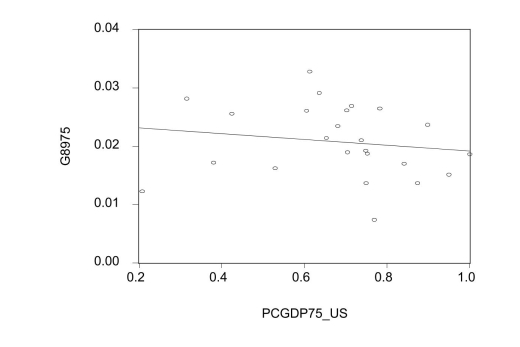You learned in intermediate macroeconomics that certain macroeconomic growth models
predict conditional convergence or a catch up effect in per capita GDP between the
countries of the world.That is, countries which are further behind initially in per-capita
GDP will grow faster than the leader.You gather data from the Penn World Tables to test
this theory.
(a)By limiting your sample to 24 OECD countries, you hope to have a more homogeneous
set of countries in your sample, i.e., countries that are not too different with respect to
their institutions.To simplify matters, you decide to only test for unconditional
convergence.In that case, the laggards catch up even without taking into account
differences in some of the driving variables.Your scatter plot and regression for the time
period 1975-1989 are as follows: 
where is the average annual growth rate of per capita GDP from 1975-1989, and PCGDP75_US is per capita GDP relative to the United States in 1975. Numbers in parenthesis are heteroskedasticity-robust standard errors. Interpret the results.Is there indication of unconditional convergence? What critical
value did you use?
Correct Answer:
Verified
View Answer
Unlock this answer now
Get Access to more Verified Answers free of charge
Q27: Consider the following panel data regression
Q28: (Requires Matrix Algebra)Consider the time and
Q29: One of the following is a regression
Q30: In Sports Economics, production functions are
Q31: Two authors published a study in
Q33: Your textbook modifies the four assumptions
Q34: Your textbook suggests an "entity-demeaned" procedure
Q36: You want to find the determinants of
Q37: Consider a panel regression of unemployment rates
Q42: A study attempts to investigate the role
Unlock this Answer For Free Now!
View this answer and more for free by performing one of the following actions

Scan the QR code to install the App and get 2 free unlocks

Unlock quizzes for free by uploading documents